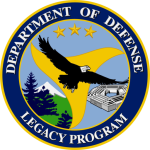FY2011
Fact Sheet: Strategic Management of Invasive Species in the Northwest United States – Workshop (Legacy 11-114).
FY2010
A natural resource data viewer web application, built by the University of Southern California Spatial Sciences Institute (SSI, 2011) for the Department of Defense Legacy Program provides an innovative digital data archive with advanced geospatial search and data retrieval capabilities. This document provides background and instructions for the transfer and use of this data viewer by the Department of Defense. The accompanying zip files allow for installation of quick keys on desktops. Instructions for loading are in the report and the Read Me file in the Flexviewer Folder.
The objective of the project was to develop an online tool to view and archive biological resource data that would be accessible to non-specialist users and be consistent with current technology specifications for the Department of the Defense and its contractors at a pilot location, the Defense Fuel Support Point insane Pedro, California.
Coral Ecosystems and Marine Resources Initiative T/E and Sensitive Species Database (Legacy 10-306)
This is an extensive compilation of information and tools for consistent management and conservation of DoD protected marine species and associated benthic/marine habitat (coral reef ecosystems), including endangered threatened and sensitive resources and habitat. The database will assist in compliance with numerous Federal Acts and Executive Orders particularly with regards to the need to inventory biologically or geographically significant or sensitive natural resources. The database provides resource information for use in decision-making regarding on-shore or near-shore activities in order to maintain military readiness with minimal adverse impacts to the marine environment. It serves as an in-house resource for locating underwater resources and identifying potential impacts related to mission needs, operations or development projects.
This presentation discusses the need and results of a multi-year effort to gather important migratory information about the Gulf sturgeon that would benefit Eglin AFB and other coastal installations within the migratory route of this species. (PowerPoint Version)
This presentation discusses the need and results of a multi-year effort to gather important migratory information about the Gulf sturgeon that would benefit Eglin AFB and other coastal installations within the migratory route of this species.
In 2003 the Apalachicola Regional Stewardship Alliance (ARSA) Cooperative Invasive Species Management Area (CISMA) was founded by stakeholders in the Apalachicola River Region, FL. TNC updated and expanded this document in June of 2011 with support from U.S. Department of Defense (DOD) Legacy Resource Management Program to include Tyndall AFB. This plan offers information necessary to implement a cooperative approach to invasive management by maximizing limited financial and personnel resources throughout the region, prioritize highly valued sites, and reduce threats on a landscape scale. Individual land managers are encouraged to use this document as a guide to implement strategies on their own sites. This method will be used as a management tool to protect the native flora and fauna of the Apalachicola River region and serve as a model for other regions. Inclusive in this report is a detailed species-specific Invasive Species Management Plan applicable to Tyndall AFB.
Fact Sheet: Tracing the Geographic Origin of Migratory Birds Breeding on DoD Lands Using Stable Isotopes (Legacy 10-427).
Fact Sheet: Status and Distribution of Le Conte’s Thrasher (Toxostoma lecontei) – a species at-risk on three southwestern military installations (Legacy 10-343).
Continuation Year 4.

